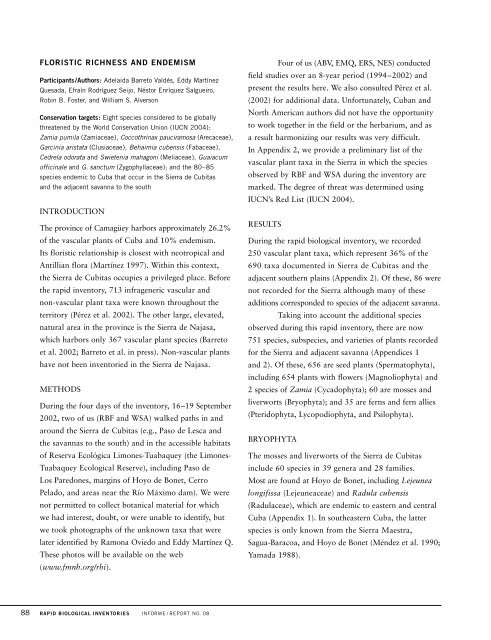Cuba: Camagüey, Sierra de Cubitas - The Field Museum
Cuba: Camagüey, Sierra de Cubitas - The Field Museum
Cuba: Camagüey, Sierra de Cubitas - The Field Museum
Create successful ePaper yourself
Turn your PDF publications into a flip-book with our unique Google optimized e-Paper software.
FLORISTIC RICHNESS AND ENDEMISM<br />
Participants/Authors: A<strong>de</strong>laida Barreto Valdés, Eddy Martínez<br />
Quesada, Efraín Rodríguez Seijo, Néstor Enríquez Salgueiro,<br />
Robin B. Foster, and William S. Alverson<br />
Conservation targets: Eight species consi<strong>de</strong>red to be globally<br />
threatened by the World Conservation Union (IUCN 2004):<br />
Zamia pumila (Zamiaceae), Coccothrinax pauciramosa (Arecaceae),<br />
Garcinia aristata (Clusiaceae), Behaimia cubensis (Fabaceae),<br />
Cedrela odorata and Swietenia mahagoni (Meliaceae), Guaiacum<br />
officinale and G. sanctum (Zygophyllaceae); and the 80–85<br />
species en<strong>de</strong>mic to <strong>Cuba</strong> that occur in the <strong>Sierra</strong> <strong>de</strong> <strong>Cubitas</strong><br />
and the adjacent savanna to the south<br />
INTRODUCTION<br />
<strong>The</strong> province of <strong>Camagüey</strong> harbors approximately 26.2%<br />
of the vascular plants of <strong>Cuba</strong> and 10% en<strong>de</strong>mism.<br />
Its floristic relationship is closest with neotropical and<br />
Antillian flora (Martínez 1997). Within this context,<br />
the <strong>Sierra</strong> <strong>de</strong> <strong>Cubitas</strong> occupies a privileged place. Before<br />
the rapid inventory, 713 infrageneric vascular and<br />
non-vascular plant taxa were known throughout the<br />
territory (Pérez et al. 2002). <strong>The</strong> other large, elevated,<br />
natural area in the province is the <strong>Sierra</strong> <strong>de</strong> Najasa,<br />
which harbors only 367 vascular plant species (Barreto<br />
et al. 2002; Barreto et al. in press). Non-vascular plants<br />
have not been inventoried in the <strong>Sierra</strong> <strong>de</strong> Najasa.<br />
METHODS<br />
During the four days of the inventory, 16–19 September<br />
2002, two of us (RBF and WSA) walked paths in and<br />
around the <strong>Sierra</strong> <strong>de</strong> <strong>Cubitas</strong> (e.g., Paso <strong>de</strong> Lesca and<br />
the savannas to the south) and in the accessible habitats<br />
of Reserva Ecológica Limones-Tuabaquey (the Limones-<br />
Tuabaquey Ecological Reserve), including Paso <strong>de</strong><br />
Los Paredones, margins of Hoyo <strong>de</strong> Bonet, Cerro<br />
Pelado, and areas near the Río Máximo dam). We were<br />
not permitted to collect botanical material for which<br />
we had interest, doubt, or were unable to i<strong>de</strong>ntify, but<br />
we took photographs of the unknown taxa that were<br />
later i<strong>de</strong>ntified by Ramona Oviedo and Eddy Martínez Q.<br />
<strong>The</strong>se photos will be available on the web<br />
(www.fmnh.org/rbi).<br />
88 RAPID BIOLOGICAL INVENTORIES INFORME/REPORT NO. 08<br />
Four of us (ABV, EMQ, ERS, NES) conducted<br />
field studies over an 8-year period (1994–2002) and<br />
present the results here. We also consulted Pérez et al.<br />
(2002) for additional data. Unfortunately, <strong>Cuba</strong>n and<br />
North American authors did not have the opportunity<br />
to work together in the field or the herbarium, and as<br />
a result harmonizing our results was very difficult.<br />
In Appendix 2, we provi<strong>de</strong> a preliminary list of the<br />
vascular plant taxa in the <strong>Sierra</strong> in which the species<br />
observed by RBF and WSA during the inventory are<br />
marked. <strong>The</strong> <strong>de</strong>gree of threat was <strong>de</strong>termined using<br />
IUCN’s Red List (IUCN 2004).<br />
RESULTS<br />
During the rapid biological inventory, we recor<strong>de</strong>d<br />
250 vascular plant taxa, which represent 36% of the<br />
690 taxa documented in <strong>Sierra</strong> <strong>de</strong> <strong>Cubitas</strong> and the<br />
adjacent southern plains (Appendix 2). Of these, 86 were<br />
not recor<strong>de</strong>d for the <strong>Sierra</strong> although many of these<br />
additions correspon<strong>de</strong>d to species of the adjacent savanna.<br />
Taking into account the additional species<br />
observed during this rapid inventory, there are now<br />
751 species, subspecies, and varieties of plants recor<strong>de</strong>d<br />
for the <strong>Sierra</strong> and adjacent savanna (Appendices 1<br />
and 2). Of these, 656 are seed plants (Spermatophyta),<br />
including 654 plants with flowers (Magnoliophyta) and<br />
2 species of Zamia (Cycadophyta); 60 are mosses and<br />
liverworts (Bryophyta); and 35 are ferns and fern allies<br />
(Pteridophyta, Lycopodiophyta, and Psilophyta).<br />
BRYOPHYTA<br />
<strong>The</strong> mosses and liverworts of the <strong>Sierra</strong> <strong>de</strong> <strong>Cubitas</strong><br />
inclu<strong>de</strong> 60 species in 39 genera and 28 families.<br />
Most are found at Hoyo <strong>de</strong> Bonet, including Lejeunea<br />
longifissa (Lejeuneaceae) and Radula cubensis<br />
(Radulaceae), which are en<strong>de</strong>mic to eastern and central<br />
<strong>Cuba</strong> (Appendix 1). In southeastern <strong>Cuba</strong>, the latter<br />
species is only known from the <strong>Sierra</strong> Maestra,<br />
Sagua-Baracoa, and Hoyo <strong>de</strong> Bonet (Mén<strong>de</strong>z et al. 1990;<br />
Yamada 1988).

















